Digital Strategies to Enhance Cultural Heritage Routes: From Integrated Survey to Digital Twins of Different European Architectural Scenarios
Abstract
1. Introduction
2. Materials and Methods
2.1. Site Description
- -
- The Upper Kama region is located north of Perm Krai, limited to the west by the chain of Ural Mountains, and to the north by the Komi region. Since the 15 century, the salt trade, from Europe beyond the Urals to China [10], has increased trade flows and intermediate settlements along this route, centered around the main districts of Solikamsk (1430), Cherdyn (1535), and Usolye (1606) [11,12]. The Upper Kama region is still composed of more than 50 monumental Orthodox complexes, spread over the territory but interconnected by a single cultural language, but where management planning aimed at protecting these assets is absent.
- -
- The route of Jaime I in Spain is a cultural itinerary that runs through those territories affected by the Catholic Reconquista of 1238 and represented by the current Provinces of Valencia, Castellón, and Alicante [13]. Although there is no real official source on the itinerary associated with Aragonese King Jaime I, the tourist and cultural promotion of this route is aimed at ideally connecting the 112 sites (religious buildings, defensive and strategic buildings, and some minor buildings) located between Teruel, where the itinerary begins, and Peñíscola, where it ends. The selection rationale of the sites investigated was dictated, on the one hand, by their consistency from a historical, geographical, and architectural point of view with the various strands belonging to the route; on the other hand, by the numerous transformations many of them have undergone over time, which have led to their progressive deterioration, abandonment and, in some cases, consequent ruin.
- -
- The fortifications in Gdańsk define an organic system, closely integrated with the city, but defining a clearly visible spatial boundary. This system consists of fortifications dating from different historical periods and therefore classifiable typologically and temporally into macro-groups (from the 10th century to the 20th century): line fortifications from the medieval period, early modern outer fortifications, and 20th century fortifications, erected and expanded to defend the New Port and the Westerplatte peninsula [14,15,16].
2.2. Integrated Survey and 3D Databases
- Territorial level: At this level, different centers within the districts are identified using a geomatic hyper-simplification model of the landscape, territory, infrastructure, and connectivity systems, as well as the potential service systems that can be linked to this scale. Specifically, during this phase, the development involved creating a simplified digital terrain model (DTM) with the main contour lines based on existing cartographic data and metric information obtained from integrated surveys (utilizing tools such as mobile laser scanners and UAVs). This model delineated the connectivity and accessibility attributes of individual monuments, outlining potential connecting pathways between religious and fortified complexes. This corresponds to LOD 0 (digital terrain model) with an accuracy level of approximately 10 m [28].
- Urban level: In this model, all the different activities and services present within the single center are identified. This level corresponds to LOD 1 (one-block model), with an approximate accuracy of 5 m.
- Monumental area level: Within the single urban center, the model of the monumental area will be deepened, in order to identify the different areas for safeguarding the historical character of the single territorial centers [29]. To this end, the landscape features of the area identified in relation to the aesthetic monumental elements within which it will be possible to identify the typological features of the monumental structures present in the area will be described in a single model. This level corresponds to LOD 2 (architectural scaled model), with an approximate accuracy of 3 m.
- Monumental building level: The various buildings present in the monumental areas, identified by the previous level of analysis, will be further investigated in this level of investigation where they will be individually described through the construction of a specific HBIM information model in which the decorative and technological features of the entire building will be represented. This level corresponds to LOD 3 (full architectural scaled model), with an approximate accuracy of 0.2 m.
3. Results
3.1. Post-Processing Data and Digital Twins
3.1.1. Upper Kama 3D Modeling
3.1.2. Jaime I 3D Modeling
3.1.3. Gdańsk Fortresses 3D Modeling
3.2. Interactive Informative Platform
- Integration of different data: The product connects different types of information content, such as cards, images, parametric models, technical drawings, and analyses. This integration likely allows for a more comprehensive understanding of the architectural sites and their spatial context.
- Significance of the spatial component: By combining spatial data with other architectural information, the product can help researchers and users better comprehend the importance of the spatial component in their analyses. This could lead to insights into the relationships between each architectural element and its surrounding.
- Accessibility for different users: The product will be designed to be user-friendly and accessible to various types of users, not just experts in the field. This inclusivity could lead to a broader range of users benefiting from the technology and contributing to architectural heritage research.
- SIS technology: Integrating SIS technology into the product can enhance the accuracy and efficiency of spatial analyses, that take into account each building with its context.
- Increase in knowledge: The product’s capabilities likely lead to a deeper understanding of the value and challenges associated with cultural heritage monuments. This increased knowledge could be instrumental in making informed decisions regarding land planning strategies and preservation efforts.
- -
- For the Upper Kama project, the three districts that comprise the various analyzed sites will be represented by a platform integrating GIS and BIM systems. The inserted models of monuments and their context (LOD 0 and LOD 1) will be associated with different information (texts related to the toponymy of historical centers and historical and current images), accessible through specific choices in a menu within the developed platform. From here, it will be possible to access a higher level of detail (LOD 2), which will feature interactive elements describing the monumental system of various buildings and their relationships with the context. Clicking on each of these buildings will delve into the detailed BIM of the individual church or monument (LOD 3), from which one can access specific information about the building.
- -
- For the Valencia route of Jaime I, the platform will not utilize simplified terrain models, but rather a web space built upon a cartographic map of the Province of Valencia. On this map, the locations of various investigated sites will be marked, represented by clickable volumes, in accordance with the geographical layout of the route. The clickable points within this virtual space will allow interaction with individual reality-based models, optimized in terms of polygon count to ensure ease of management and navigation. Furthermore, these models will be semantically decomposed according to a technological–constructive organization of the historical phases that have impacted the sites. In this manner, by selecting a portion or element of a specific phase, it will be possible to access cards containing textual, graphical, and photographic data that enhance the reading and comprehension of the navigable 3D models.
- -
- For the route of the fortifications in the center of Gdańsk, an idealized platform of the city has been designed, where distances and dimensions of various elements have been rethought in relation to their perception within the urban complex. Houses, streets, and minor urban features have been simplified and placed with variable dimensions based on their perceived significance. Similarly, fortified elements have been modeled based on conducted surveys and proportionally inserted with larger dimensions compared with other elements on the platform. Structured on Unreal Engine 4, the platform aims to emphasize the defensive system of the Polish route. It becomes clickable, enabling access to detailed models of each fortified element. These models have been obtained through mathematical NURBS modeling processes, as well as mesh or parametric modeling for some of the most representative buildings (Figure 13).
4. Discussion
Author Contributions
Funding
Data Availability Statement
Acknowledgments
Conflicts of Interest
References
- Parrinello, S.; Picchio, F.; De Marco, R.; Dell’Amico, A. Documenting The Cultural Heritage Routes. The Creation of Informative Models of Historical Russian Churches on Upper Kama Region. Int. Arch. Photogramm. Remote Sens. Spat. Inf. Sci. 2019, XLII-2/W15, 887–894. [Google Scholar] [CrossRef]
- Logan, W. Cultural diversity, cultural heritage, and human rights: Towards heritage management as human rights-based cultural practice. Int. J. Herit. Stud. 2012, 18, 231–244. [Google Scholar] [CrossRef]
- Zhou, L. Cultural routes and the network construction of the World Cultural Heritage Conservation. In Proceedings of the ICOMOS 15th General Assembly and Scientific Symposium Monuments and Sites in their Setting-Conserving Cultural Heritage in Changing Townscapes and Landscapes, Section IV: Cultural Routes: The Challenges of Linear Settings for Monuments and Sites, Xi’an, China, 17–21 October 2005; pp. 17–21. [Google Scholar]
- Oikonomopoulou, E.T.; Delegou, E.; Sayas, J.; Moropoulou, A. An innovative approach to the protection of cultural heritage: The case of cultural routes in Chios Island, Greece. J. Archaeol. Sci. Rep. 2017, 14, 742–757. [Google Scholar] [CrossRef]
- Ćosović, M.; Maksimović, M. Application of the Digital Twin concept in cultural heritage. In Proceedings of the 1st International Virtual Conference on Visual Pattern Extraction and Recognition for Cultural Heritage Understanding, Pescara, Italy, 12–13 September 2022. [Google Scholar]
- Okanovic, V.; Ivkovic-Kihic, I.; Boskovic, D.; Mijatovic, B.; Prazina, I.; Skaljo, E.; Rizvic, S. Interaction in eXtended Reality Applications for Cultural Heritage. Appl. Sci. 2022, 12, 1241. [Google Scholar] [CrossRef]
- Liestøl, G. Augmented Reality Storytelling–Narrative Design and Reconstruction of a Historical Event in Situ; International Association of Online Engineering: Vienna, Austria, 2019; pp. 196–209. Available online: https://www.learntechlib.org/p/216412/ (accessed on 26 July 2023).
- Sullivan, A.M. Cultural heritage & new media: A future for the past. J. Marshall Rev. Intell. Prop. L. 2015, 15, 604. [Google Scholar]
- Available online: https://www.prometheush2020.eu (accessed on 26 July 2023).
- Brumfield, W.C. The Architectural Heritage of Solikamsk and the Northern Districts of Perm Province. Cah. Slaves 2008, 10, 317–355. [Google Scholar] [CrossRef]
- Brumfield, W.C. Usolye: Stroganov outpost in the Urals. Russia and India Report. Open Source. Available online: https://www.rbth.com/articles/2011/08/11/usolye_stroganov_outpost_in_the_urals_12850 (accessed on 1 July 2019).
- Parrinello, S.; Cioli, F. Un progetto di recupero per il complesso monumentale di Usolye nella regione della Kama Superiore. Restauro Archeol. 2018, 26, 92–111. [Google Scholar]
- Swift, F.D. The Life and Times of James the First the Conqueror; Clarendon Press: Oxford, UK, 1894. [Google Scholar]
- Biskup, K. Rejony ograniczeń budowlanych twierdzy gdańskiej w wiekach XIX i XX [Areas of construction limitations of the Gdańsk fortress in the 19th and 20th centuries]. In Gdańsk Pomnik Historii; Kostarczyk, A., Ed.; PL_ Regionalny Ośrodek Studiów i Ochrony Środowiska Kulturowego: Gdańs, Poland, 1998. [Google Scholar]
- Borucka, J.; Gatermann, H. Architekturführer Danzig: Gdańsk Sopot Gdynia. [Gdańsk Architectural Guide Danzig: Gdańsk Sopot Gdynia]; DOM Publishers: Berlin, Germany, 2016. [Google Scholar]
- Szczepański, J.; Dymnicka, M. Dilemmas of Identity in Contemporary Cities. The City of Gdańsk as an Example. Procedia Eng. 2016, 161, 1225–1229. [Google Scholar] [CrossRef][Green Version]
- Cullen, G. Concise Townscape; Routledge: London, UK, 2012. [Google Scholar]
- Bandarin, F.; Van Oers, R. The Historic Urban Landscape: Managing Heritage in An Urban Century; John Wiley & Sons: Hoboken, NJ, USA, 2012. [Google Scholar]
- Santagati, C.; Lo Turco, M. From structure from motion to historical building information modeling: Populating a semantic-aware library of architectural elements. J. Electron. Imaging 2017, 26, 011007. [Google Scholar] [CrossRef]
- Garau, C. Emerging technologies and cultural tourism: Opportunities for a cultural urban tourism research agenda. In Tourism in the City: Towards An Integrative Agenda on Urban Tourism; Springer: Cham, Switzerland, 2017; pp. 67–80. [Google Scholar]
- Pierrot-Deseilligny, M.; De Luca, L.; Remondino, R. Automated image-based procedures for accurate artifacts 3D modeling and orthoimage generation. Geoinformatics Fce Ctu 2011, 6, 291–299. [Google Scholar] [CrossRef]
- Daneshmand, M.; Helmi, A.; Avots, E.; Noroozi, F.; Alisinanoglu, F.; Arslan, H.S.; Anbarjafari, G. 3d scanning: A comprehensive survey. arXiv 2018, arXiv:1801.08863. [Google Scholar]
- La Placa, S.; Doria, E. Reliability of Dtms Obtained with Mobile Fast Surveys Techniques. Int. Arch. Photogramm. Remote Sens. Spat. Inf. Sci. 2022, 46, 299–306. [Google Scholar] [CrossRef]
- Bevilacqua, M.G.; Russo, M.; Giordano, A.; Spallone, R. 3D reconstruction, digital twinning, and virtual reality: Architectural heritage applications. In Proceedings of the 2022 IEEE Conference on Virtual Reality and 3D User Interfaces Abstracts and Workshops (VRW), Christchurch, New Zealand, 12–16 March 2022; IEEE: Piscataway, NJ, USA, 2022; pp. 92–96. [Google Scholar]
- Russo, M. AR in the Architecture Domain: State of the Art. Appl. Sci. 2021, 11, 6800. [Google Scholar] [CrossRef]
- Spanò, A.; Patrucco, G.; Sammartano, G.; Perri, S.; Avena, M.; Fillia, E.; Milan, S. Digital Twinning for 20th Century Concrete Heritage: HBIM Cognitive Model for Torino Esposizioni Halls. Sensors 2023, 23, 4791. [Google Scholar] [CrossRef] [PubMed]
- Badenko, V.; Fedotov, A.; Zotov, D.; Lytkin, S.; Volgin, D.; Garg, R.D.; Liu, M. Scan-to-BIM methodology adapted for different application. Int. Arch. Photogramm. Remote Sens. Spat. Inf. Sci. 2019, 42, 1–7. [Google Scholar] [CrossRef]
- Over, M.; Schilling, A.; Neubauer, S.; Zipf, A. Generating web-based 3D City Models from OpenStreetMap: The current situation in Germany. Comput. Environ. Urban Syst. 2010, 34, 496–507. [Google Scholar] [CrossRef]
- Donato, V.; Biagini, C.; Bertini, G.; Marsugli, F. Challenges and opportunities for the implementation of H-BIM with regards to historical infrastructures: A case study of the Ponte Giorgini in Castiglione della Pescaia (Grosseto-Italy). Int. Arch. Photogramm. Remote Sens. Spatial Inf. Sci. 2017, XLII–5/W1, 253–260. [Google Scholar] [CrossRef]
- Müller, P.; Wonka, P.; Haegler, S.; Ulmer, A.; Van Gool, L. Procedural modeling of buildings. In ACM SIGGRAPH 2006 Papers; ACM: New York, NY, USA, 2006; pp. 614–623. [Google Scholar]
- Laing, R.; Leon, M.; Isaacs, J.; Georgiev, D. Scan to BIM: The development of a clear workflow for the incorporation of point clouds within a BIM environment. WIT Trans. Built Environ. 2015, 149, 279–289. [Google Scholar]
- Chiabrando, F.; Donato, V.; Lo Turco, M.; Santagati, C. Cultural heritage documentation, analysis and management using building information modelling: State of the art and perspectives. Mechatron. Cult. Herit. Civ. Eng. 2018, 92, 181–202. [Google Scholar]
- Sanseverino, A.; Messina, B.; Limongiello, M.; Guida, C.G. An HBIM Methodology for the Accurate and Georeferenced Reconstruction of Urban Contexts Surveyed by UAV: The Case of the Castle of Charles V. Remote Sens. 2022, 14, 3688. [Google Scholar] [CrossRef]
- Dell’Amico, A. HBIM and digital documentation for development reliable parametric models on complex systems. In AIP Conference Proceedings; AIP Publishing: Long Island, NY, USA, 2021; Volume 2428, p. 1. [Google Scholar]
- Dell’Amico, A. Memoria e modello digitale. La costruzione di un sistema informativo per la salvaguardia del patrimonio architettonico diffuso dell’Upper Kama. Restauro Archeol. 2022, 30, 32–53. [Google Scholar] [CrossRef]
- Canevese, E.P.; De Gottardo, T. Beyond point clouds and virtual reality. Innovative methods and technologies for the protection and promotion of cultural heritage. Int. Arch. Photogramm. Remote Sens. Spat. Inf. Sci. 2017, 42, 685–691. [Google Scholar] [CrossRef]
- Statham, N. Scientific rigour of online platforms for 3D visualization of heritage. Virtual Archaeol. Rev. 2019, 10, 1–16. [Google Scholar] [CrossRef]
- Rahaman, H.; Champion, E.; Bekele, M. From photo to 3D to mixed reality: A complete workflow for cultural heritage visualisation and experience. Digit. Appl. Archaeol. Cult. Herit. 2019, 13, e00102. [Google Scholar] [CrossRef]
- Colucci, E.; De Ruvo, V.; Lingua, A.; Matrone, F.; Rizzo, G. HBIM-GIS integration: From IFC to cityGML standard for damaged cultural heritage in a multiscale 3D GIS. Appl. Sci. 2020, 10, 1356. [Google Scholar] [CrossRef]
- Myers, B.; Hudson, S.E.; Pausch, R. Past, present, and future of user interface software tools. ACM Trans. Comput.-Hum. Interact. (TOCHI) 2000, 7, 3–28. [Google Scholar] [CrossRef]
- Tzima, S.; Styliaras, G.; Bassounas, A. Augmented reality applications in education: Teachers point of view. Educ. Sci. 2019, 9, 99. [Google Scholar] [CrossRef]
- Skarlatos, D.; Agrafiotis, P.; Balogh, T.; Bruno, F.; Castro, F.; Petriaggi, B.D.; Rizvic, S. Project iMARECULTURE: Advanced VR, iMmersive serious games and augmented REality as tools to raise awareness and access to European underwater CULTURal heritagE. In Proceedings of the Digital Heritage, Progress in Cultural Heritage: Documentation, Preservation, and Protection: 6th International Conference, EuroMed 2016, Nicosia, Cyprus, 31 October–5 November 2016; Springer International Publishing: Cham, Switzerland, 2016; pp. 805–813. [Google Scholar]
- De Marco, R.; Pettineo, A. The recognition of Heritage qualities from feature-based digital procedures in the analysis of historical urban contexts. Int. Arch. Photogramm. Remote Sens. Spatial Inf. Sci. 2022, XLVI–2/W1–2022, 175–182. [Google Scholar] [CrossRef]
- Rechichi, F.; Mandelli, A.; Achille, C.; Fassi, F. Sharing high-resolution models and information on web: The web module of BIM3DSG system. Int. Arch. Photogramm. Remote Sens. Spat. Inf. Sci. 2016, 41, 703–710. [Google Scholar] [CrossRef]
- Saccucci, M.; Pelliccio, A. Integrated BIM-GIS System for the enhancement of urban heritage. In Proceedings of the 2018 Metrology for Archaeology and Cultural Heritage (MetroArchaeo), Cassino, Italy, 22–24 October 2018; pp. 222–226. [Google Scholar]
- Lombardo, V.; Damiano, R. Storytelling on mobile devices for cultural heritage. New Rev. Hypermedia Multimed. 2012, 18, 11–35. [Google Scholar] [CrossRef]

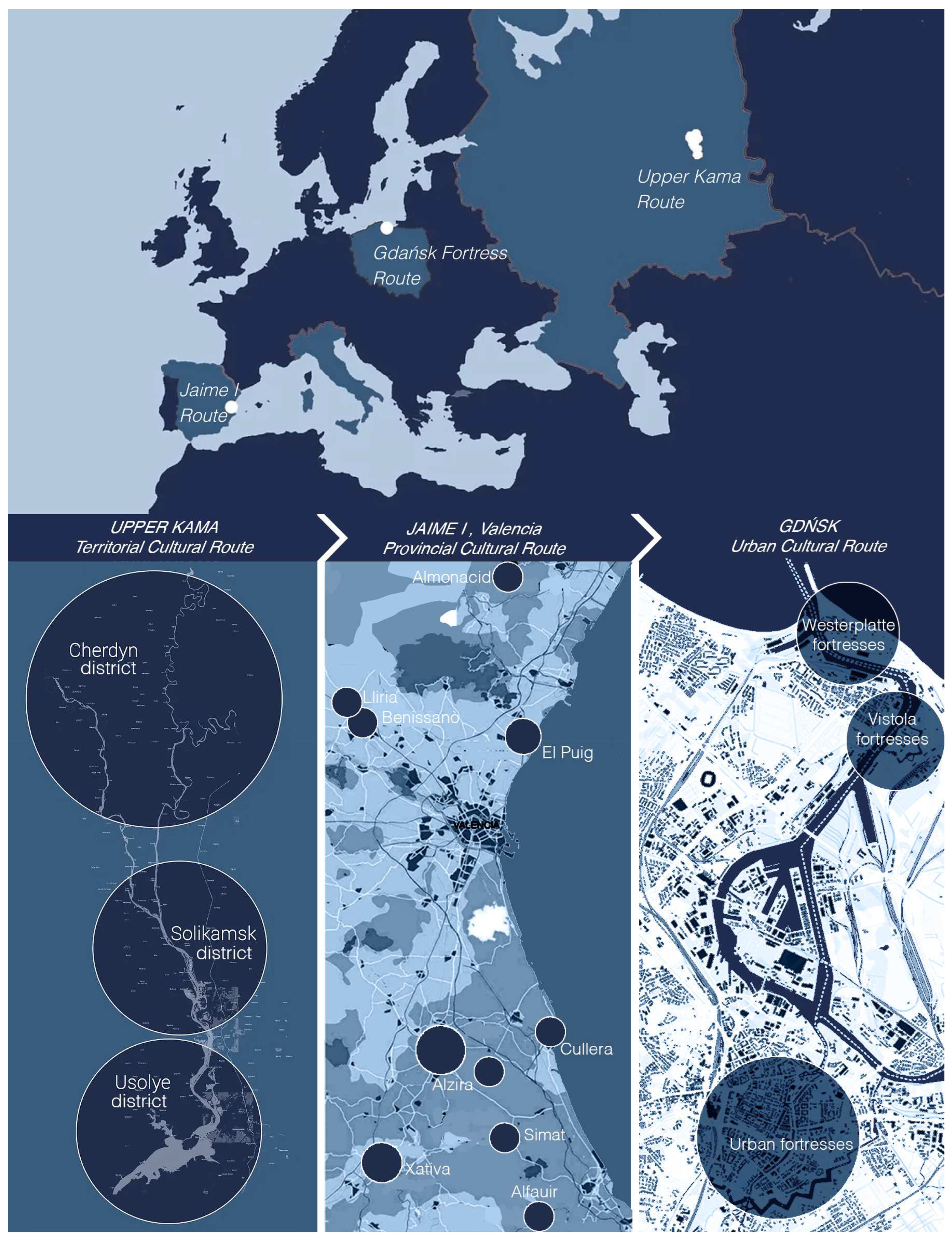
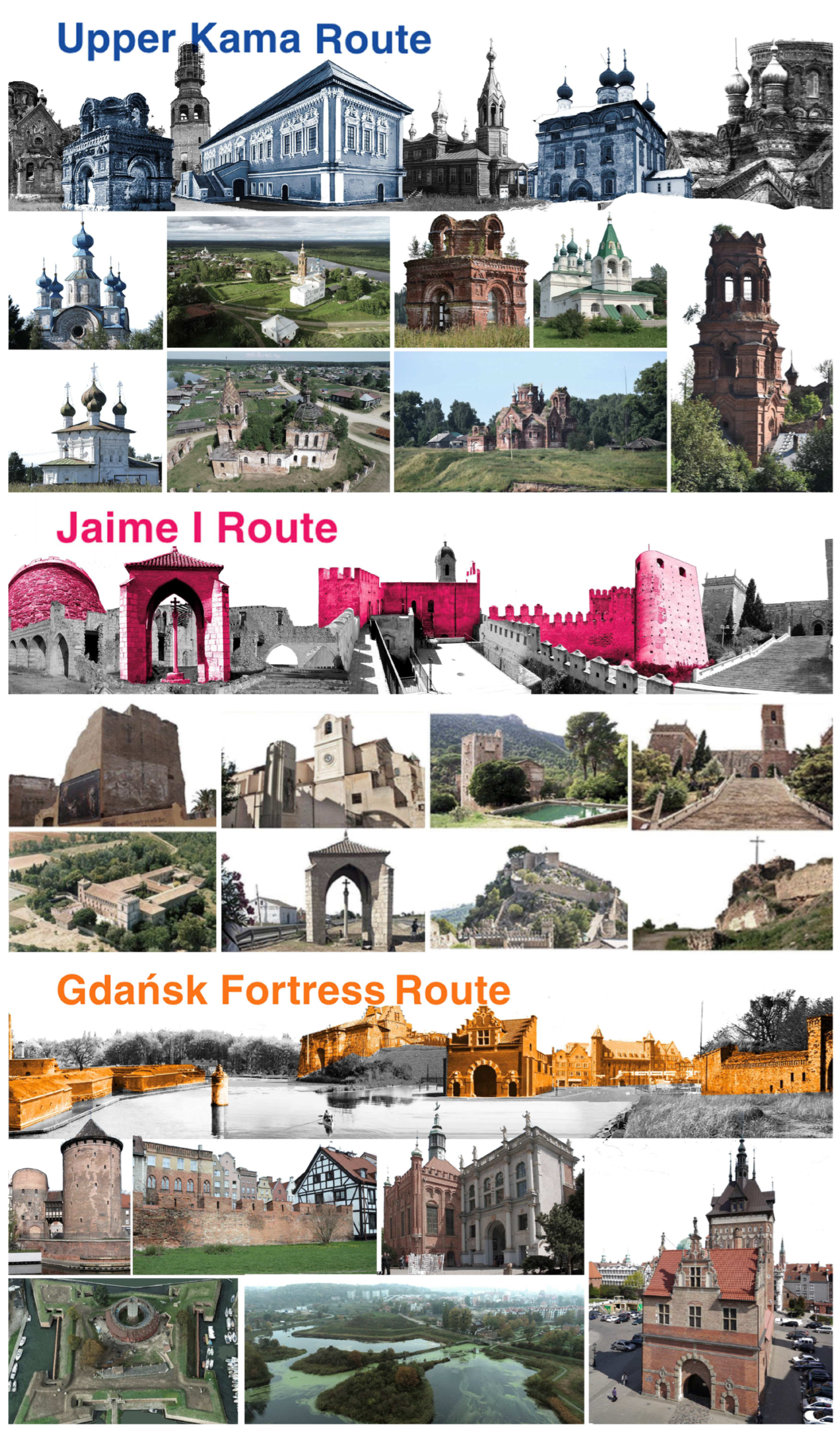


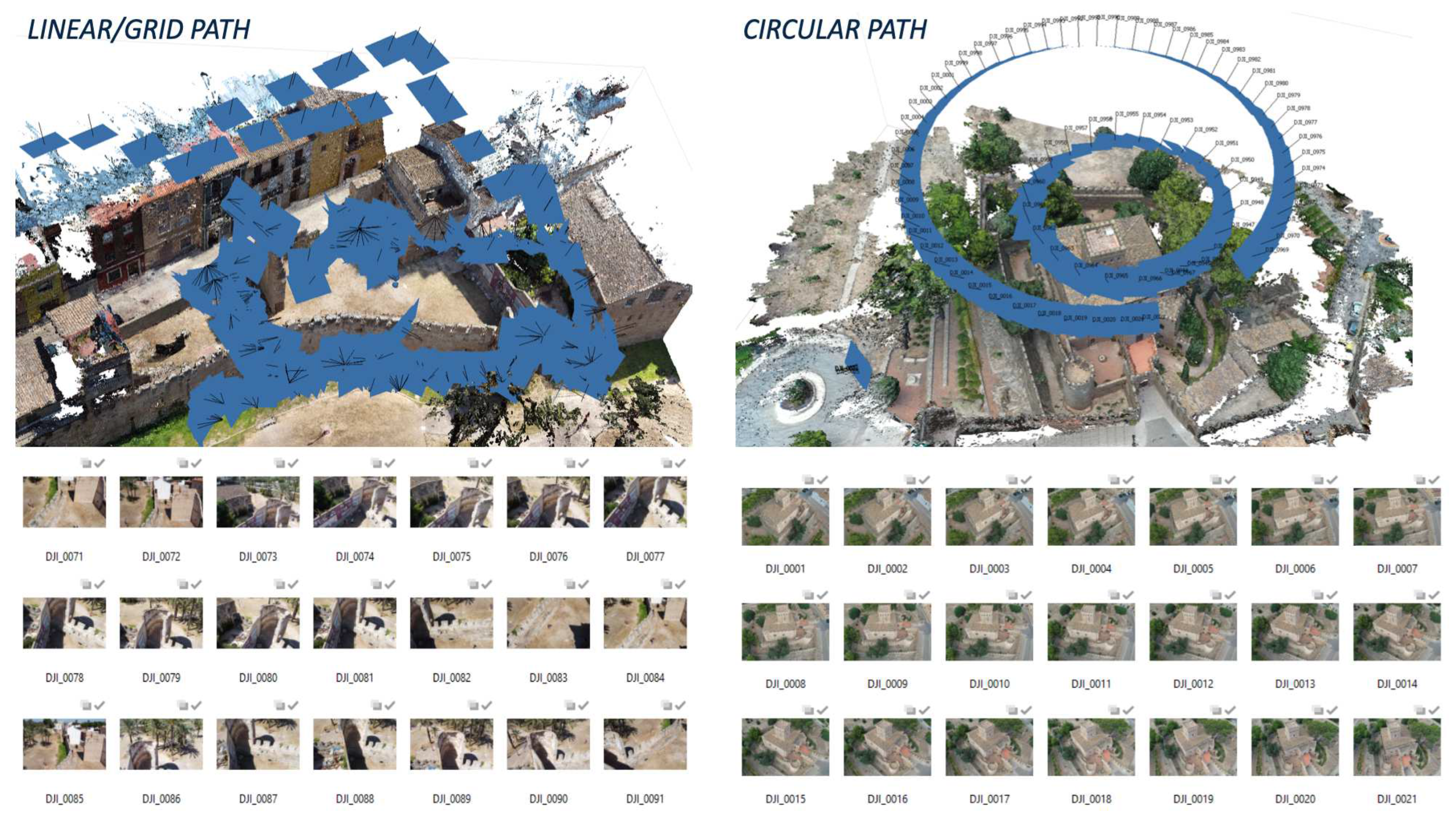
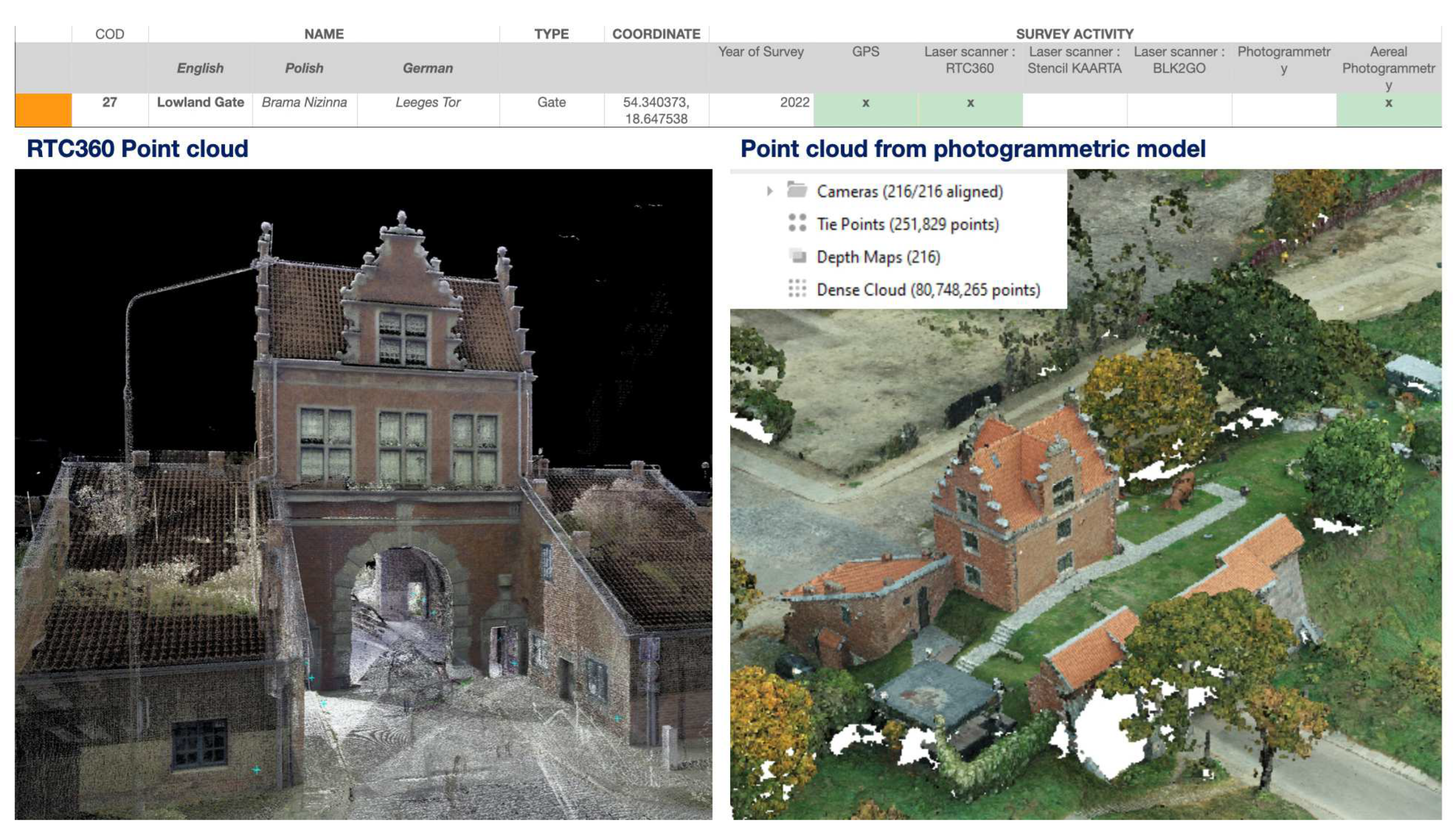
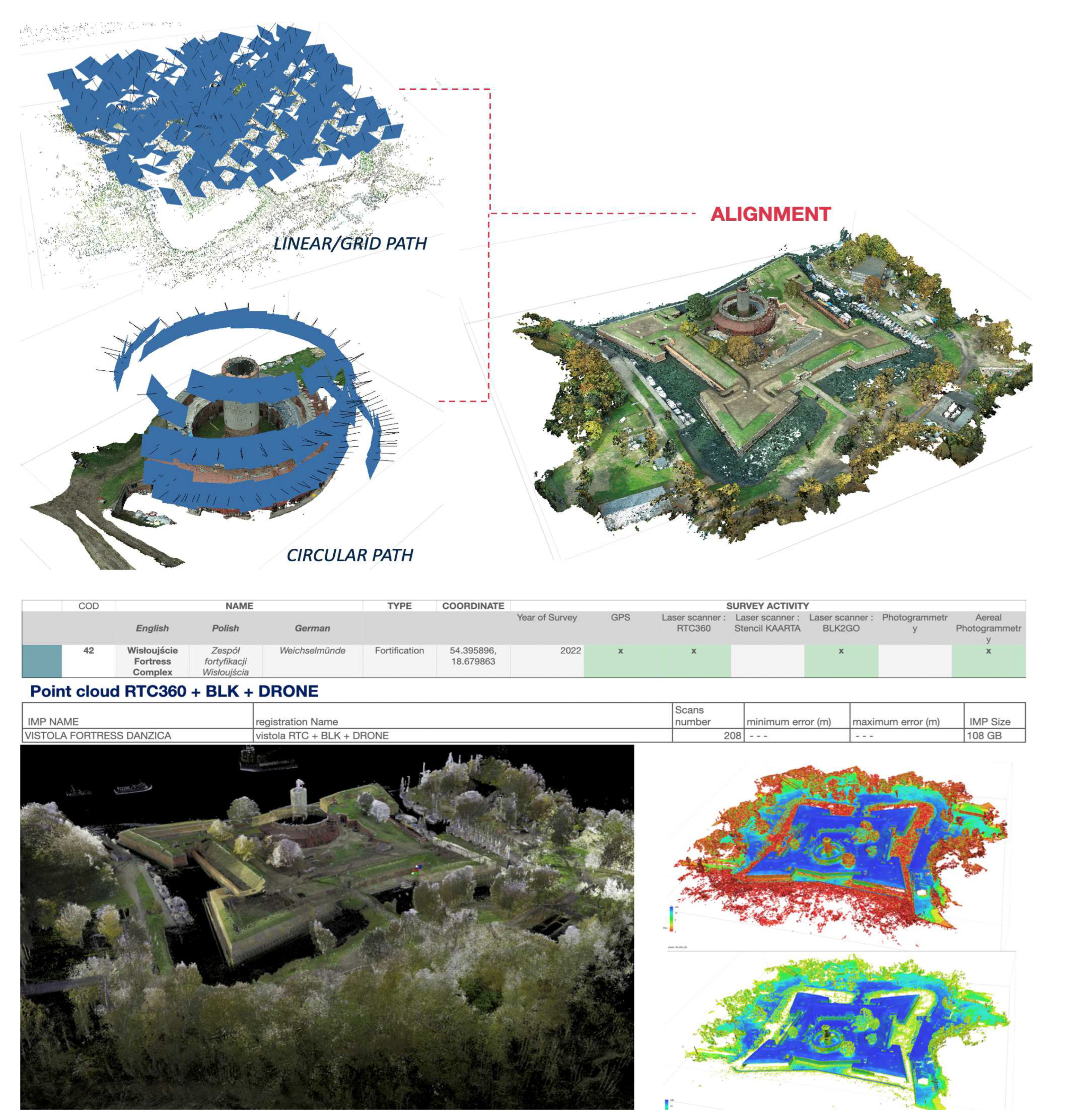

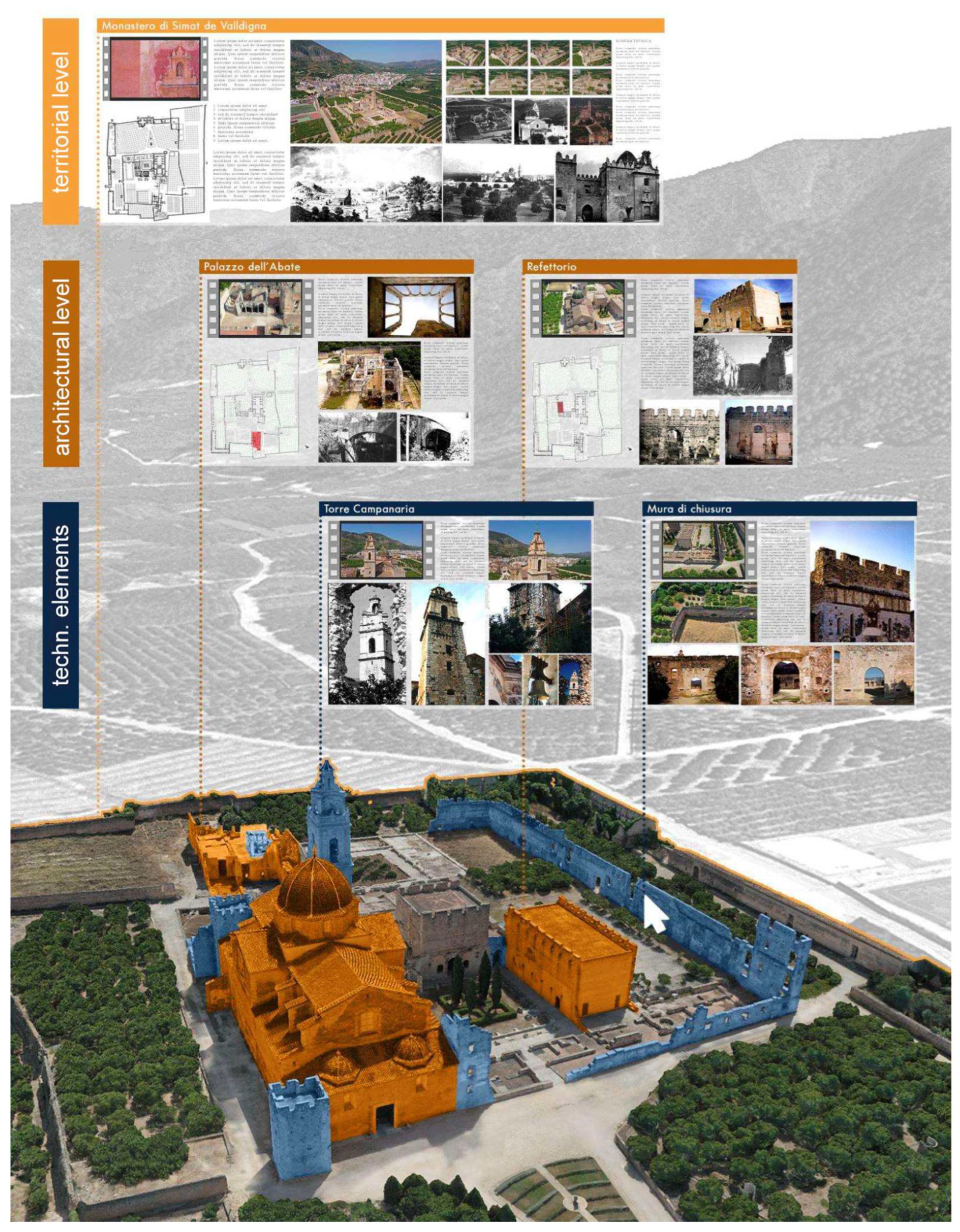
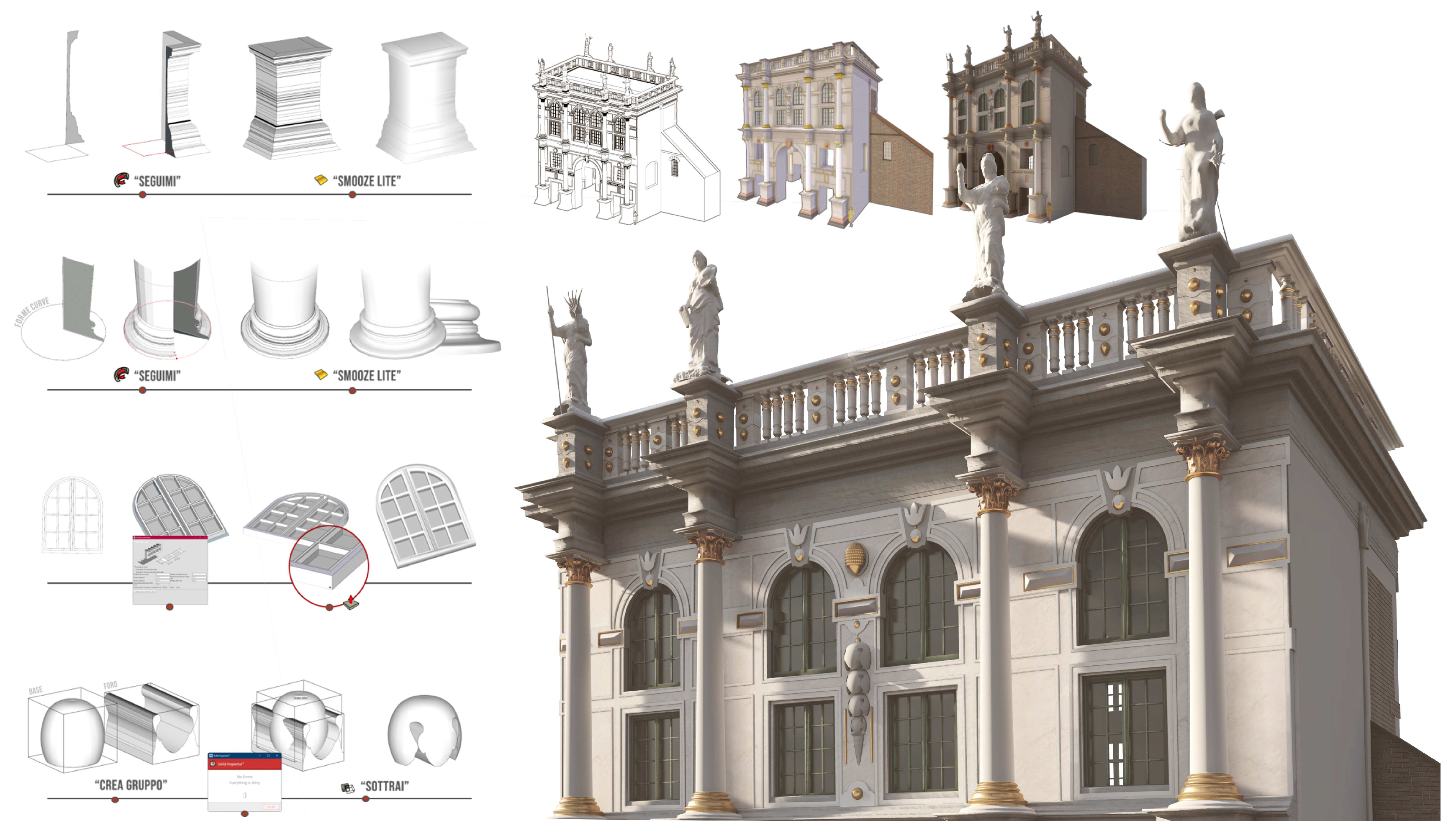
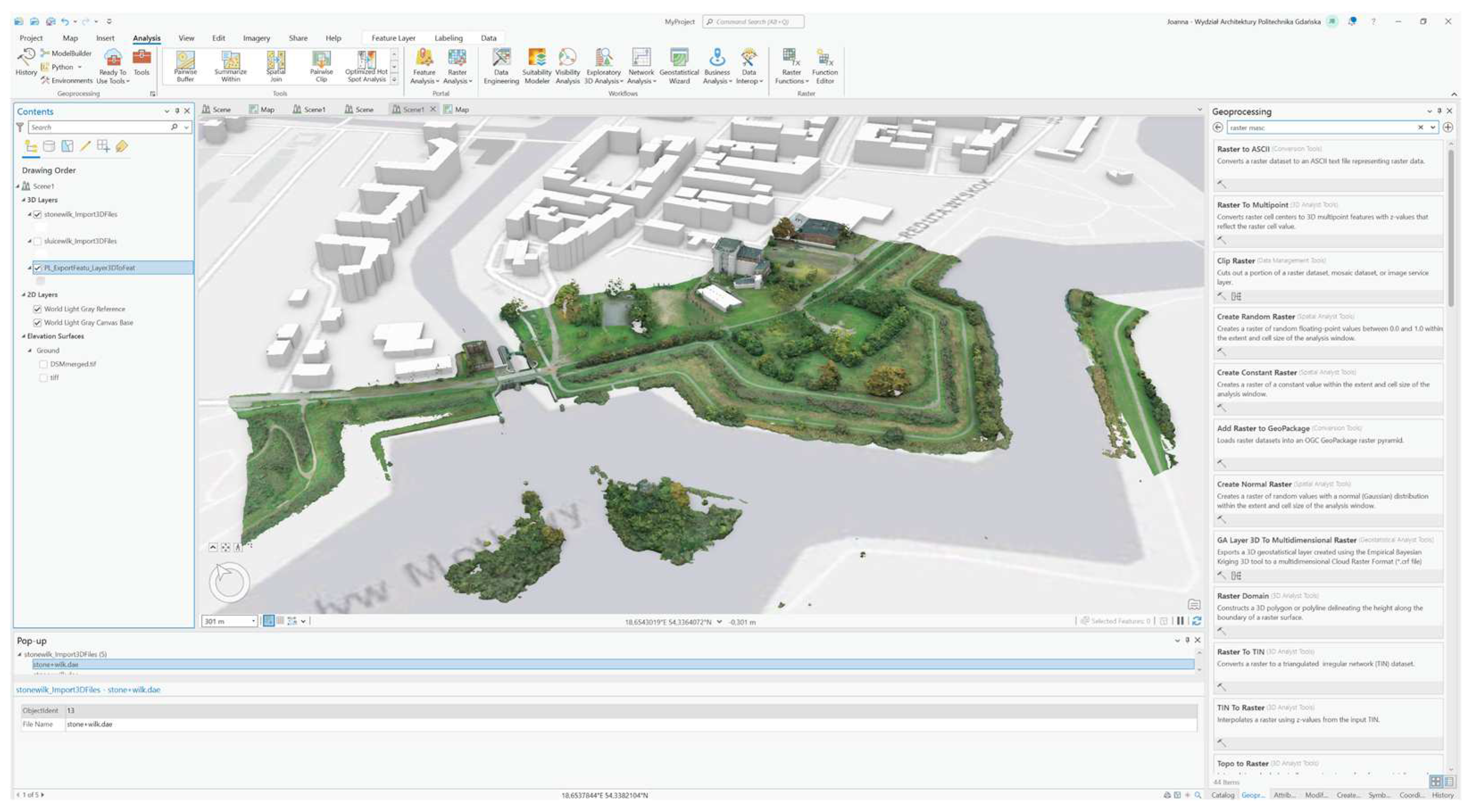

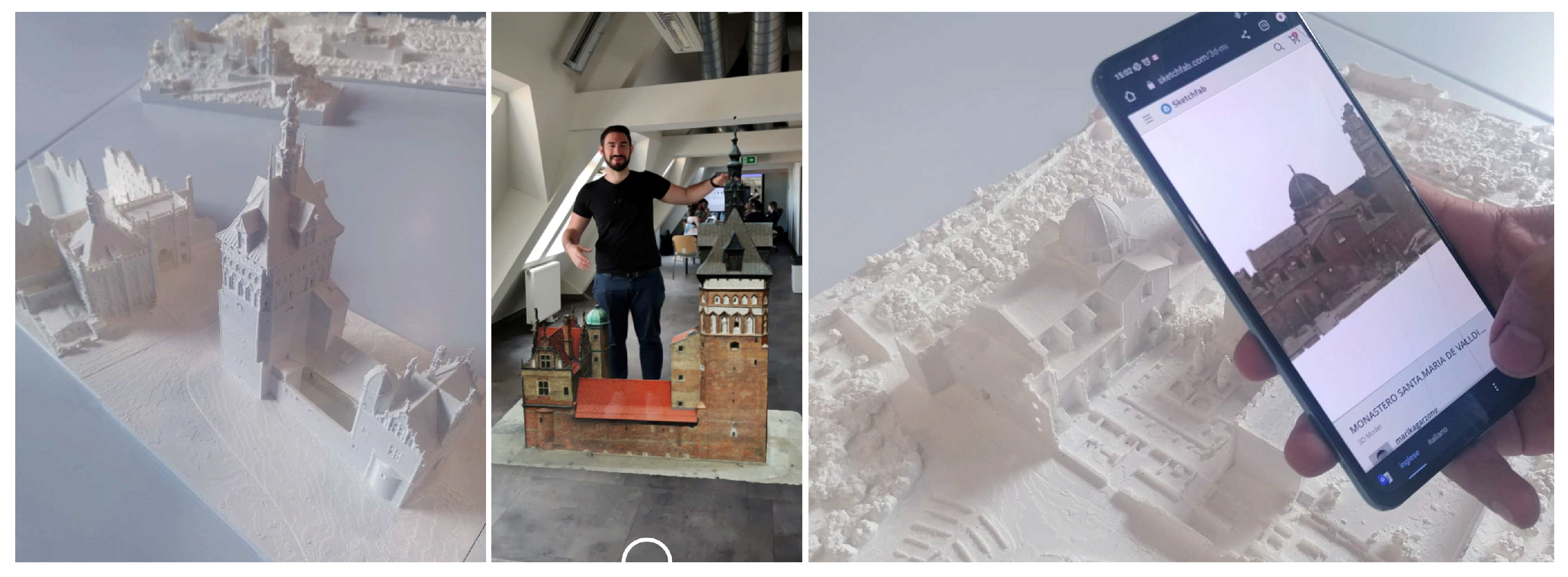

Disclaimer/Publisher’s Note: The statements, opinions and data contained in all publications are solely those of the individual author(s) and contributor(s) and not of MDPI and/or the editor(s). MDPI and/or the editor(s) disclaim responsibility for any injury to people or property resulting from any ideas, methods, instructions or products referred to in the content. |
© 2023 by the authors. Licensee MDPI, Basel, Switzerland. This article is an open access article distributed under the terms and conditions of the Creative Commons Attribution (CC BY) license (https://creativecommons.org/licenses/by/4.0/).
Share and Cite
Parrinello, S.; Picchio, F. Digital Strategies to Enhance Cultural Heritage Routes: From Integrated Survey to Digital Twins of Different European Architectural Scenarios. Drones 2023, 7, 576. https://doi.org/10.3390/drones7090576
Parrinello S, Picchio F. Digital Strategies to Enhance Cultural Heritage Routes: From Integrated Survey to Digital Twins of Different European Architectural Scenarios. Drones. 2023; 7(9):576. https://doi.org/10.3390/drones7090576
Chicago/Turabian StyleParrinello, Sandro, and Francesca Picchio. 2023. "Digital Strategies to Enhance Cultural Heritage Routes: From Integrated Survey to Digital Twins of Different European Architectural Scenarios" Drones 7, no. 9: 576. https://doi.org/10.3390/drones7090576
APA StyleParrinello, S., & Picchio, F. (2023). Digital Strategies to Enhance Cultural Heritage Routes: From Integrated Survey to Digital Twins of Different European Architectural Scenarios. Drones, 7(9), 576. https://doi.org/10.3390/drones7090576






